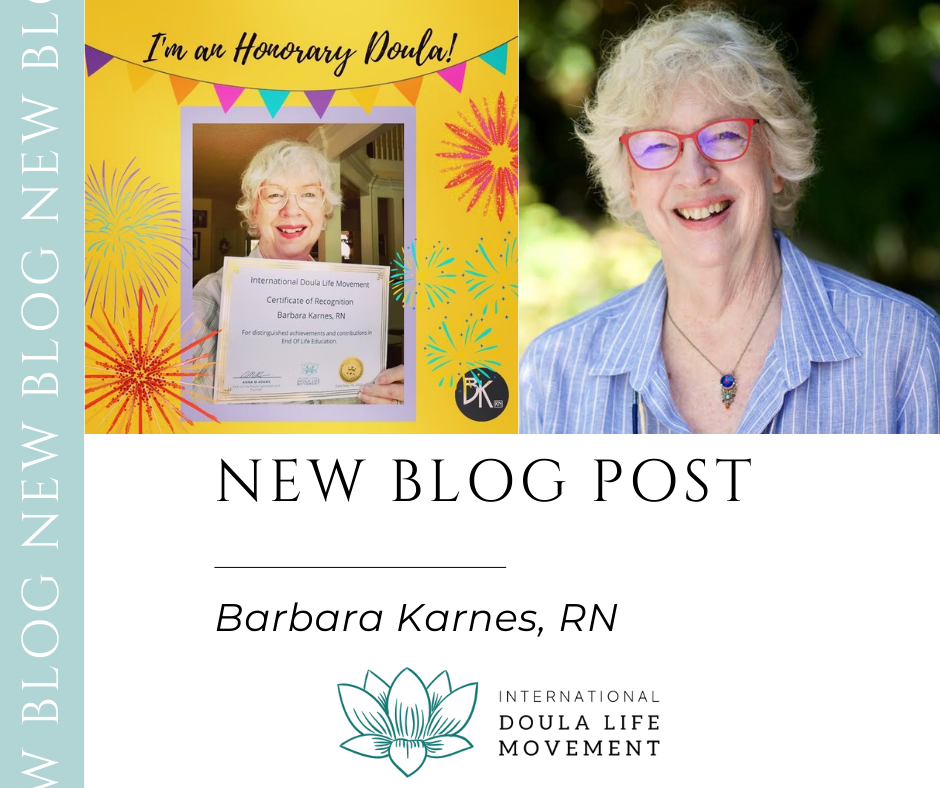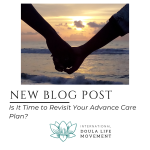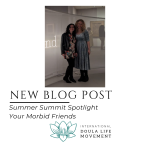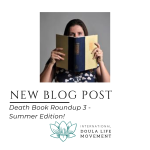I think most of us here in the IDLM community would agree that the idea of working as a death doula feels like a pretty new development. Every single one of us has had the experience (probably many times!) of telling a new acquaintance what it is we do, only to be told, “Wow, I’ve never heard of that!”
As far as the world is concerned, the concept of a death doula is a pretty new idea. But the truth is, people have been doing this work for others for as long as people have been dying—which is forever. And within IDLM, we have wonderful teachers, leaders, and role models who have been doing this work for decades.
One of these role models is the fabulous lady who will be serving as the keynote speaker at IDLM’s Tree of Life conference in November, Barbara Karnes. A pioneer of the hospice movement, Ms Karnes has won multiple awards as an End of Life Educator and the author of a number of educational booklets on death and dying which are invaluable for anyone who has lost or is in the process of losing a loved one, and essential for everyone working in end of life work. This week we are honored to spotlight Ms Karnes for our blog, in her own words.
How did you find your way to a focus in end of life work?
I graduated from nursing school in the 1960s and decided I had made a huge mistake. I should never have been a nurse, I should have been a social worker. So I never worked in the medical arena. I raised a family and did a lot of self-exploration, and then in the 1970s, Elisabeth Kubler Ross came forward and said, “We Americans are not taking care of our dying.” And that sort of sparked an interest. And at the same time, Dame Cecily Saunders in England developed what she was calling a hospice, which was taking care of people at the end of life, and I thought, oh, this is something that I would like to do.
In hindsight, I think my never having worked in the medical arena was the gift that I brought to end of life, because I had no background or conditioning on what to do as death approaches. And for the first five years, being a primary care hospice nurse, it was my patients and their families that taught me what I know today. They taught me how peope die; that there’s a process. Those patients and families were my teachers. And the rest, you know, is history.
That’s wonderful. So from there, what gave you the idea to begin writing your booklets? What was the process that led to that?
One night I was on call, three o clock in the morning. Mom is in the bed, days away, maybe a week away from death, and I’m sitting with the family in the living room. And I’m explaining to them… what mom’s doing, that it’s normal, what to look for in the coming days. And one of the daughters was taking notes. I thought, Oh my goodness. She shouldn’t have to take notes! So that weekend I thought, I’m going to write something for my patient’s families.
And this is before computers. I sat down with a yellow legal pad, and I wrote out what I wanted families to know about approaching death. First I wrote it out on a piece of paper but then I thought, no, this is not personal enough. It’s flimsy. It’s going to get lost, or torn. So I put together a booklet, and my goal was to have it with no medical-ese, no medical terminology. To have it short, because no one is going to read a whole book, under these circumstances, and to keep it gentle. So that’s how GONE FROM MY SIGHT came to be. (https://bkbooks.com/products/gone-from-my-sight-the-dying-experience?variant=36961181171868)
Then, as hospice grew and changed, families had less and less of the nurse actually there with them at the moment of death. And the moment of death is our goal! That’s our work, is to create that sacred experience that they will cary with them forever, as a sacred memory. And most families today—as they were when I wrote THE ELEVENTH HOUR (—most families are alone, even though they are on hospice, when their special person dies. So I wrote THE ELEVENTH HOUR (https://bkbooks.com/products/the-eleventh-hour-a-caring-guideline-for-the-hours-to-minutes-before-death?variant=36961177075868) as a companion to GONE FROM MY SIGHT. GONE FROM MY SIGHT says, here’s the signs of approaching death. And THE ELEVENTH HOUR says, here is what you can do while this is happening.
Then I started getting letters from families saying, Mom died two months ago and I want five more of GONE FROM MY SIGHT. And I thought, they don’t really need GONE FROM MY SIGHT, although it is helpful, for them to understand that what Mom did was normal. But I thought, they really need something dealing with grief. So I wrote MY FRIEND I CARE. Then dementia came on to the scene, and I wrote HOW DO I KNOW YOU? And now pain has become a huge issue, with families not understanding pain at end of life, so I wrote PAIN AT END OF LIFE.
My new book, which is coming out probably next month, is on food. Because people don’t understand that as end of life approaches, the need for food decreases. It’s kind of like labor and delivery. We go through labor to get here—we go through labor to leave. And think about when a baby’s born. The first thing they get is water, and then milk, and then soft foods, and gradually they reach a point where they’re eating regular food. As death approaches, the reverse occurs. They’re going to stop eating regular food, then it gets to soft food, then it gets to liquids, then it gets to water… and then it’s time. So people need to understand this. It’s one of the major caregiver challenges.
Can you share something from your work that you found to be especially surprising or meaningful?
When I got started, I knew nothing, basically. But what I learned that I hadn’t thought about, that I hadn’t even been trained to think about in the medical model, was the role of the caregiver. That is as big a role in end of life as what we do for the patient. I mean, hospice says, we take care of the family and the patient, but I think that often gets lost in the shuffle, and that more energy is concentrated on the patient. And yet, the caregiver has to go on living when this is all over. And so a big part of end of life support is supporting that caregiver, so this is a sacred experience that they will then carry with them forever. I think that was my biggest lesson.
With hospice, so much of our focusing is leading up to the moment of death. That’s what we concentrate on. But the caregivers and the families need as much support after the death as they do leading up to it. And hospice does have their bereavement programs and things like that, but supporting the families is where end of life doulas can really make a difference, because you stay there and help with not just the grieving process, but… those hours following the death, they are so important. They are vital. And yet most people are alone when, for example, the funeral home comes. Like, well, it’s over.
I would love to hear your thoughts on the current death positive movement. Things like Death Cafes, the work of Caitlin Doughty and the Order of the Good Death, the growing number of people being attracted to end of life work. Do you have any opinions about that?
I think the more conversations we have about end of life, the better it is for everyone because everybody dies! And we’re such a death-denying society, we’re so concentrated on fixing people, even who aren’t fixable, that the more we have a conversation, whether it’s death cafes or whatever, the more we have the opportunity to educate about end of life, and that will provide more support to people.
It used to be that Grandma died at home. She got sick at home and she ended up in the upstairs bedroom, and there she died. And family was there, neighbors were there, everyone was supportive, and we watched as grandma died. It was a normal part of life. And then hospitals came along, and then nursing facilities, and as those grew in popularity, more and more Grandma died in a facility. Family often wasn’t even there. And she was alone, and no one knew, no one was there to learn from her experience. So now we’re a society that is blind to what’s normal and what’s not normal when it comes to dying. All we see is the medical end of it.
So I’m thinking that end of life doulas, being outside the medical model, are going to bring this communal support back to people dying, and help people see how normal death is. And we get that sense when we are there at the bedside. However, if we are there at the bedside and there isn’t support, if there isn’t an end of life doula, or hospice, or if you’re not at a nursing facility that really understands end of life—if they aren’t there, death becomes a frightening experience. We have the opportunity to make that not happen, to help the family and the patient to have a sacred experience.
What advice would you give to someone just beginning their journey on the path of end of life work?
The first thing you need to do is look at yourself, and understand what is drawing you to this type of work. That’s paramount. You need to understand yourself before you can help others, so that’s very important.
Then, if you decide yes, this is what I want to do, then you have to remember to take care of yourself. Develop some rituals. Support for yourself, so you can stay in the work. It’s intense, you’re working outside of what most people think, and so you—we—are kind of the outliers. We have to understand ourselves, and put ourselves first. Put our own oxygen masks on first.
We who are drawn to this work are drawn more from our heart, as opposed to our mind, and that makes us doers and givers. And oftentimes a doer and a giver will put themselves last… but we need to remember to take care of ourselves as our top priority.
Please visit Ms.Kernes website at www.bkbooks.com






